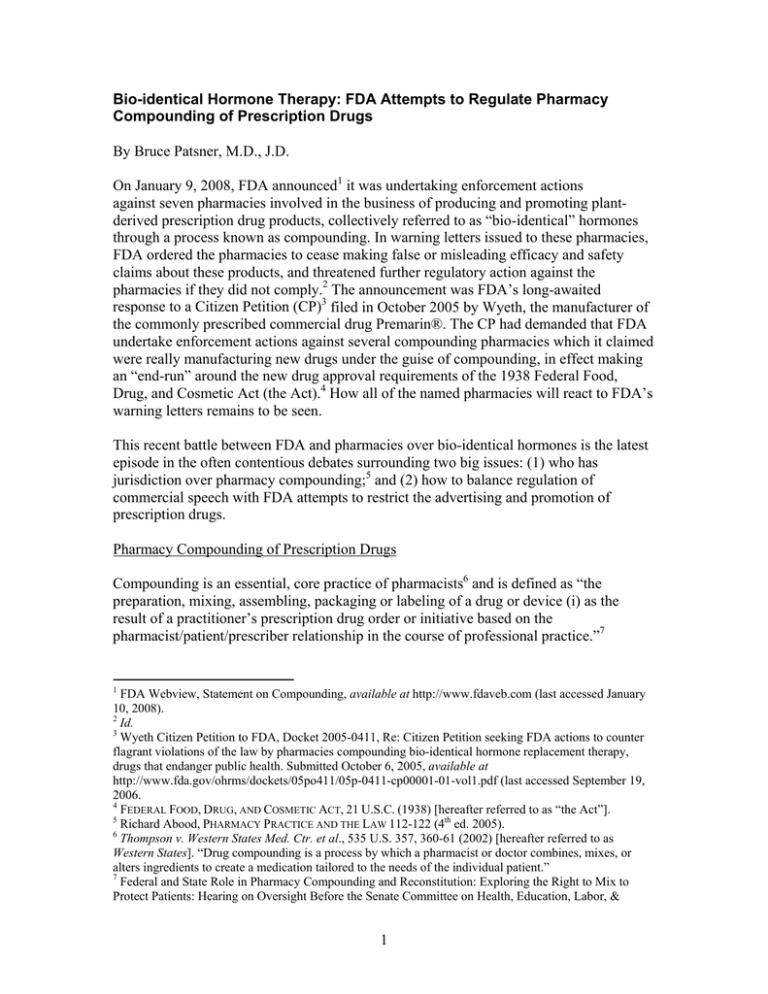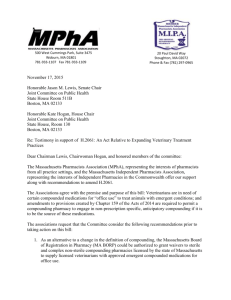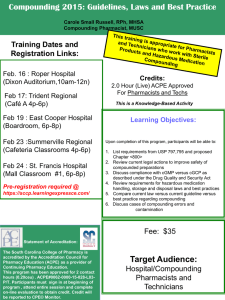Bio-identical Hormone Therapy: FDA Attempts to Regulate Pharmacy
advertisement

Bio-identical Hormone Therapy: FDA Attempts to Regulate Pharmacy Compounding of Prescription Drugs By Bruce Patsner, M.D., J.D. On January 9, 2008, FDA announced1 it was undertaking enforcement actions against seven pharmacies involved in the business of producing and promoting plantderived prescription drug products, collectively referred to as “bio-identical” hormones through a process known as compounding. In warning letters issued to these pharmacies, FDA ordered the pharmacies to cease making false or misleading efficacy and safety claims about these products, and threatened further regulatory action against the pharmacies if they did not comply.2 The announcement was FDA’s long-awaited response to a Citizen Petition (CP)3 filed in October 2005 by Wyeth, the manufacturer of the commonly prescribed commercial drug Premarin®. The CP had demanded that FDA undertake enforcement actions against several compounding pharmacies which it claimed were really manufacturing new drugs under the guise of compounding, in effect making an “end-run” around the new drug approval requirements of the 1938 Federal Food, Drug, and Cosmetic Act (the Act).4 How all of the named pharmacies will react to FDA’s warning letters remains to be seen. This recent battle between FDA and pharmacies over bio-identical hormones is the latest episode in the often contentious debates surrounding two big issues: (1) who has jurisdiction over pharmacy compounding;5 and (2) how to balance regulation of commercial speech with FDA attempts to restrict the advertising and promotion of prescription drugs. Pharmacy Compounding of Prescription Drugs Compounding is an essential, core practice of pharmacists6 and is defined as “the preparation, mixing, assembling, packaging or labeling of a drug or device (i) as the result of a practitioner’s prescription drug order or initiative based on the pharmacist/patient/prescriber relationship in the course of professional practice.”7 1 FDA Webview, Statement on Compounding, available at http://www.fdaveb.com (last accessed January 10, 2008). 2 Id. 3 Wyeth Citizen Petition to FDA, Docket 2005-0411, Re: Citizen Petition seeking FDA actions to counter flagrant violations of the law by pharmacies compounding bio-identical hormone replacement therapy, drugs that endanger public health. Submitted October 6, 2005, available at http://www.fda.gov/ohrms/dockets/05po411/05p-0411-cp00001-01-vol1.pdf (last accessed September 19, 2006. 4 FEDERAL FOOD, DRUG, AND COSMETIC ACT, 21 U.S.C. (1938) [hereafter referred to as “the Act”]. 5 Richard Abood, PHARMACY PRACTICE AND THE LAW 112-122 (4th ed. 2005). 6 Thompson v. Western States Med. Ctr. et al., 535 U.S. 357, 360-61 (2002) [hereafter referred to as Western States]. “Drug compounding is a process by which a pharmacist or doctor combines, mixes, or alters ingredients to create a medication tailored to the needs of the individual patient.” 7 Federal and State Role in Pharmacy Compounding and Reconstitution: Exploring the Right to Mix to Protect Patients: Hearing on Oversight Before the Senate Committee on Health, Education, Labor, & 1 Compounding is the preparation of a “customized” prescription drug product for a patient whose physician has determined that his or her medical needs cannot be met by a commercially manufactured prescription drug product (for example, a pediatric patient who needs a prescription drug in liquid form yet no drug company makes the drug in this formulation). Compounded drugs are thus individualized and by the pharmacy profession’s own statements before Congress8 are never intended as wholesale replacements for comparable commercial prescription drugs known to be safe and effective. At the present time, however, multiple compounding pharmacies have been advertising and promoting bio-identical hormone therapy to an anonymous, national audience of women as a safer and more effective alternative for treatment of menopause than commonly prescribed commercially manufactured prescription drugs. Consumers may not be aware of the fact that there is virtually no data to support many of the internet claims being made for bio-identical hormones, but major medical societies such as the American College of Obstetricians and Gynecologists9 and the Endocrine Society have repetitively gone on record at meetings,10 in journals,11 and before Congress12 for years stating that the health claims being made for bio-identical hormones have no firm evidentiary basis. The pharmacy industry has consistently argued13 that compounding of prescription drugs is part of routine pharmacy practice and thus subject to regulation only by the individual states through their state boards of pharmacy. The pharmacy industry thus sees no role for FDA in regulation of pharmacy compounding even though it involves prescription drugs which have, by design, never undergone formal safety and efficacy testing unlike nearly all commercially manufactured prescription drugs. FDA argues that it has at least some jurisdiction over pharmacy compounding.14 Clearly the change in the manner of Pensions, 108th Congress (2003) (statement of Daniel A. Herbert, RPh, President-Elect, American Pharmaceutical Association) [hereafter abbreviated as “Herbert testimony”]. 8 Id. 9 American College of Obstetricians and Gynecologists (ACOG) Committee Opinion, Committee on Gynecologic Practice, Compounded Bioidentical Hormones, No. 322, November 2005. 10 Lila E. Nachtigall MD, Bioidentical versus Nonbioidentical Hormones, PROCEEDINGS FROM THE POSTGRADUATE COURSE PRESENTED PRIOR TO THE 17TH ANNUAL MEETING OF THE NORTH AMERICAN MENOPAUSE SOCIETY (October 11, 2006)[Hereafter abbreviated Nachtigall testimony]. 11 Bridget M Kuehn, FDA Warns Claims for Pharmacy-Made “Bio-identical” Hormones are Misleading, 299 JAMA 512 (2008). 12 The Endocrine Society, Senate Investigates Bioidentical Hormones. The Endocrine Society As Expert Witness, ENDOCRINE NEWS, June 2007. U.S. Senate Special Committee on Aging, April 19, 2007. 13 Herbert testimony, supra note 7. 14 Bio-Identical Hormones: Sound Science or Bad Medicine?, Hearing Before the Senate Special Committee on Aging 110th Congress (2007) (prepared statement of Steven K. Galson, M.D., Director of the Center for Drug Evaluation and Research at FDA). [Hereafter abbreviated as Galson testimony]. During this presentation Dr. Galson reiterated FDA’s view that compounded drugs are “new drugs” within the meaning of the Act despite recent judicial rulings directly negating this contention. Were this argument accepted, the practice of pharmacy compounding, essential to patient care, would cease to exist because no pharmacy could meet the efficacy and safety new drug approval requirements of the Act. For this reason, FDA chooses to exercise “enforcement discretion” over pharmacy compounding, not seeking to disturb “traditional compounding” (however defined), and intervening when it determines (FDA’s second 2 promotion of bio-identical hormones by some predominately internet-based pharmacies, as well as the non-individualized audience they are being marketed to, has raised significant concerns over whether the pharmacy activity in question is the traditional compounding FDA has expressed it has little interest in interfering with,15 or whether what is going on is another kind of pharmacy activity, however defined. The Problem of FDA Jurisdiction Over Compounding The clash between FDA and the pharmacy compounding industry is not a new one, and has been in a state of flux even since the Supreme Court’s Western States decision16 of 2002 affirmed the 9th Circuit’s decisions17 that (1) the compounding pharmacy advertising and soliciting restrictions of § 503A of the 1997 Food and Drug Administration Modernization Act (FDAMA)18 were violations of the First Amendment and unconstitutional restrictions on commercial speech under the Central Hudson test; and (2) these speech restrictions were not severable from all of the remaining language dealing with pharmacy compounding. As a result of the Supreme Court’s decision the entirety of section 503A was void19 and the entire portion of the Act which dealt with pharmacy compounding was eliminated. Ironically, had FDAMA not contained provisions which ran afoul of First Amendment commercial speech doctrine, §503A would have eliminated much of the current controversy since it formally acknowledged that pharmacy compounded prescription drugs were not “new drugs,” as defined by the Act,20 and exempted compounded drugs which satisfied certain requirements from having to satisfy three key provisions of the Act: (1) the adulteration provision of section 501(a)(2); (2) the misbranding provision of 501(f)(1); and (3) the new drug approval provisions of section 505.21 Despite Western States, FDA continues to maintain that it has at least some jurisdiction over pharmacy compounding. The 2002 Compliance Policy Guide22 (CPG) contains a list of the factors FDA considers in deciding whether to exercise its enforcement discretion.23 Among those factors are whether a compounded product may have a potential adverse effect on the public health, whether a firm is compounding finished drugs from bulk active ingredients that are not components of FDA-approved drugs, or whether a firm is compounding drugs that are “versions” of drugs that were withdrawn or removed from argument for jurisdiction) that the pharmacy activity is really manufacturing. As noted, there are problems with this argument as well. 15 Id. 16 Western States, supra note 6. 17 Western States Medical Center v. Shalala, 238 F.3rd 1090 (9th Circuit 2001). 18 FOOD AND DRUG ADMINISTRATION MODERNIZATION ACT OF 1997, 21 U.S.C. 301 (1997). [Hereafter abbreviated as FDAMA]. 19 Galson testimony, supra note 14. 20 FDAMA, supra note 18. 21 Id. 22 FDA Compliance Policy Guide § 460.200, at Policy 1, available at http://www.fda.gov/ora/compliance_ref/cpg/cpgdrg/cpg460-200.html (hereinafter FDA 2002 Compliance Guide) (last accessed January 11, 2008). 23 Id. 3 the market for safety reasons.24 The CPG also notes that “FDA recognizes that pharmacists have traditionally extemporaneously compounded and manipulated reasonable quantities of human drugs upon receipt of a valid prescription for an individually identified patient from a licensed practitioner. This traditional activity is not the subject of this guidance.”25 No definition of “reasonable quantity” of compounding, or “traditional compounding” are provided in recent FDA testimony before Congress on the issue of bio-identical hormones, and the current enforcement actions do not contain a guideline by which FDA can consistently distinguish among those compounding pharmacies it seeks to regulate from those it does not. Federal Courts Have Not Yet Favored FDA Attempts to Regulate Compounding Federal judges have consistently rejected the notion that pharmacy compounded prescription drugs are “new drugs” as defined by the 1938 Federal Food, Drug, and Cosmetic Act.26 This holding was most recently re-asserted in the August 30, 2006 decision by United States District Court for the Western District of Texas Medical Center Pharmacy v. Gonzales.27 In this bench trial a federal judge granted the plaintiffs’ motion for summary judgment against FDA and held, among other things, that lawfully compounded prescription drugs for humans fall outside the definition of “new drugs.”28 The Court forcefully rejected FDA’s efforts to claim that a pharmacy compounded drug is a “new drug” and to assert jurisdiction over prescription drug compounding by this argument.29 Specifically, the Court found that “extemporaneous compounding of drugs is authorized under 21 U.S.C. §353a (Section 503A of the FDCA) and such compounding is thereby exempted from the [new] drug approval process and outside the scope of the definitions of ‘new drug’ and ‘new animal drug’ under sections 201(p)(1) and (v)(1) of the FDCA.”30 This decision has been appealed to the 5th Circuit Court of Appeals; at the time of this writing a decision is pending. The other argument which both FDA and the pharmaceutical industry have made in court against compounding pharmacies is to claim that they are really “manufacturers.” This argument is also problematic. First, there is a statutory basis for the straightforward notion that a pharmacy engaged in the practice of compounding cannot, by definition, be a manufacturer, and is therefore not subject to the manufacturing requirements of the Act.31 Second, federal judges have rejected the “volume of business” argument as a way 24 Id. Id. 26 Under the specific language of 21 U.S.C. §§ 360(g)(1) and 374 (a)(2)(A), pharmacies are expressly exempt from FDA registration as manufacturers FDAMA’s original provisions essentially exempted the overwhelming majority of compounded prescription drugs from the core new drug approval requirements of the Act. The FDCA does contain exemptions to its manufacturing provisions for pharmacies. 27 Medical Center Pharmacy v. Gonzales, 451 F. Supp. 2d 854 (W.D. Tex. 2006). 28 Id. 29 Id. 30 Covington & Burling. Food & Drug E-Alert. “Western District of Texas Compounding Decision on Medical Center Pharmacy v. Gonzales. September 27, 2006, available at www.cov.com (last accessed December 23, 2007). 31 Under the specific language of 21 U.S.C. §§ 360(g)(1) and 374 (a)(2)(A), pharmacies are expressly exempt from FDA registration as manufacturers FDAMA’s original provisions essentially exempted the 25 4 of demonstrating that “manufacturing” instead of “compounding” is occurring.32 Indeed, the court in the first Western States decision rejected this line of reasoning in unusually forceful terms,33 and this approach was tacitly affirmed by all courts in the subsequent Western States decisions.34 Given that compounding pharmacies may prepare compound prescription drugs in reasonable anticipation of receiving a prescription, and that some compounding pharmacies will, because of economies of scale, unavoidably be involved in the production of large numbers of similar compounded prescription drugs (particularly so for BHRT), it is an unavoidable that there will be some large volume compounding by some pharmacies. Adding to the confusion has been the use of the terms “traditional compounding” and “bulk compounding” by HHS Chief Counsel without providing meaningful definitions of either term.35 Is FDA’s Enforcement Action Appropriate? Is What’s Going On Really Compounding? Of course, the “traditional compounding” both FDA and the pharmacy industry constantly refer to is an undefined entity which both the internet, entrepreneurial pharmacy business practices and pharmacy industry economies of scale are relegating to the past. However, both FDA and the pharmacy profession employ similar definitions of what compounding is (and by implication what “traditional compounding” is), and this definition36 actually provides some guidance as to how FDA can assert jurisdiction, and control, over some of the predominately internet-based pharmacies promoting compounded bio-identical hormones. Promoting bio-identical hormone therapies as a wholesale replacement for all women instead of commercially available prescription drugs which are known to be safe and effective is, by the Pharmacy industry’s own overwhelming majority of compounded prescription drugs from the core new drug approval requirements of the Act. The FDCA does contain exemptions to its manufacturing provisions for pharmacies. The statute exempts pharmacies from the registration and inspection requirements for manufacturers provided the pharmacies meet certain requirements, such as complying with state laws and performing compounding activities in their normal course of business, and as such protects a broad range of pharmacy compounding practices from the traditional regulatory requirements of manufacturers.. 32 Western States Medical Center v. Shalala, supra note 17. 33 Id. U.S. District Court Judge David A. Ezra unequivocally held that volume “does nothing” to distinguish manufacturing from compounding.” 34 Id.. 35 Daniel Meron, Legal Developments Relevant to FDA Authority, 62 FOOD & DRUG L. J. 443 (2007). “But when volume or other circumstances of compounding suggest that the pharmacy is actually acting like a drug manufacturer, FDA will consider enforcement actions. In short, FDA has strived to preserve the many beneficial instances of traditional compounding, while at the same time making sure that abusive practices, involving bulk compounding, remain the subject of our enforcement.” 36 US FOOD AND DRUG ADMINISTRATION, CENTER FOR DRUG EVALUATION AND RESEARCH, FDA CONCEPT PAPER: DRUG PRODUCTS THAT PRESENT DEMONSTRABLE DIFFICULTIES FOR COMPOUNDING BECAUSE OF REASONS OF SAFETY OR EFFECTIVENESS, available at http://www.fda.gov/cder/fdama/difconc.htm (last accessed July 25, 2005). A “compounded drug product is a drug product made in response to, or in anticipation of, receipt of a valid prescription order or a notation on a valid prescription order from a licensed practitioner that states the compounded product is necessary for the identified patient.” In many instances of use of bio-identical hormone prescriptions the substitution over a commercial drug product is not “necessary” in the medical sense. 5 admission, not compounding.37 This opens the door to an FDA argument that what is being done is not compounding. A recent comprehensive review of bio-identical hormone therapy38 concluded that “although individualized hormone products may decrease some symptoms of menopause, it seems they have no proven advantage over conventional hormone therapies and their use is not supported by evidence regarding pharmacokinetics, safety, and efficacy.”39 There is enough legitimate direct scientific literature to demonstrate that many of the medical benefit and safety claims made by some internet-based compounding pharmacies are either blatantly false or scientifically impossible.40 Just as importantly, the essential “triad” relationship41 between patient, physician, and compounding pharmacist which characterized true compounding is absent in some of these compounding activities when pharmacies actively solicit patient business directly via the internet instead of waiting to receive prescriptions from a physician. Conclusion The real question is whether FDA is prepared to undertake more drastic action to reign in a pharmacy practice which is a real public health issue and thus well within FDA’s mission statement.42 As it is, it took FDA almost three years from the time of its initial review of Wyeth’s Citizen’s Petition to respond, and then all it did was send warning letters to seven pharmacies, none of which are the biggest players in the bio-identical hormone therapy industry. FDA already lacks the medical resources to adequately monitor post-marketing surveillance of drugs, devices, vaccines, and foods in the United States;43 whether it is prepared to seize large batches of bio-identical hormones made by compounding pharmacies is open to question. However, if FDA elects to fulfill its mission and decides to engage select compounding pharmacies head-on, it will have to come up with something other than the new drug or manufacturing arguments consistently rejected by federal courts. Health Law Perspectives (May 2008), available at: http://www.law.uh.edu/healthlaw/perspectives/homepage.asp 37 Herbert testimony, supra note 7. “The profession’s definition of compounding does not encompass the preparation of massive amounts of a drug product with the contemplation of distribution to a mass market of unknown users in unknown venues.” 38 Lisa A Boothby, Paul L. Doering and Simon Kipersztok, Bioidentical hormone therapy: a review, 11 MENOPAUSE 356 (2004). 39 Id. 40 Nachtigall testimony, supra note 10. See also Tara Parker-Pope, Popular Menopause Hormones Made From Plants Come Under Scrutiny, WALL STREET JOURNAL, October 25, 2001, at D1. 41 Herbert testimony, supra note 7. 42 FDA's Mission Statement, at http://www.fda.gov/opacom/morechoices/mission.html (last visited April 13, 2006). 43 Editorial, The F.D.A. in Crisis: It Needs More Money and Talent, N.Y. TIMES, February 3, 1953 available at http://www.nytimes.com/2008/02/03/opinion/03sun1.html (last accessed February 9, 2008). 6





